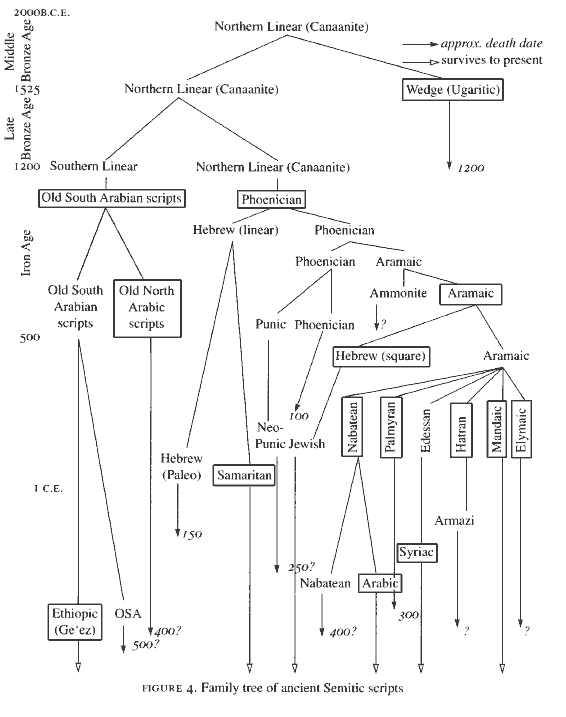- Previous message: Christopher John Fynn: "Re: Aramaic unification and information retrieval"
- In reply to: [email protected]: "Re: Ancient Northwest Semitic Script"
- Next in thread: Michael Everson: "Re: Ancient Northwest Semitic Script"
- Reply: Michael Everson: "Re: Ancient Northwest Semitic Script"
- Reply: Christopher John Fynn: "Re: Ancient Northwest Semitic Script"
- Messages sorted by: [ date ] [ thread ] [ subject ] [ author ] [ attachment ]
- Mail actions: [ respond to this message ] [ mail a new topic ]
[email protected] wrote at 3:25 AM on Saturday, December 27, 2003:
>(smile) If you're referring to "Old Italic", it's in Plane One.
No. I'm referring to Latin.
>Besides, would it be fair to say that many
>paleographers and script taxonomists have been interested in computer
>encoding all along?
Certainly not, to my knowledge, those working with ancient Semitic scripts.
>But, in either case it is hoped that the needs of script
>taxonomists and paleographers won't be disregarded.
So Unicode is now prepared to provide support, in plain text, for the
needs of paleographers?
>> Well I, for one, prefer to read in more paleographically relevant
>> renderings; and fonts combined with markup will, of course, take care of
>> everything.
>
>That's not very useful in plain text. Unicode is an encoding standard for
>plain text.
Fraktur has precisely the same plain text rendering issues.
>> But not the Phoenician, Punic, Moabite, Ammonite, Old Hebrew, and Old
>> Aramaic nodes. In fact, the glyphic, or paleographic, variation is so
>> slight at times between texts in these languages and dialects, that it is
>> the extra-script evidence that is diagnostic for identification.
>
>Quoting from N2311.PDF:
This document by Michael Everson is particularly revealing and in the end
damning to his whole attempt at disunification of the Northwest Semitic
script.
><quote>
>Phoenician encompasses:
> Proto-Sinaitic/Proto-Canaanite
> Punic
> Neo-Punic
> Phoenician proper
> Late Phoenician cursive
> Phoenician papyrus
> Siloam Hebrew
> Hebrew seals
> Ammonite
> Moabite
> Palaeo-Hebrew
><end quote>
If we compare this list to the taxonomic chart he reproduces on the next
page (see the attachment), we see convenient, but nevertheless glaring,
discrepancies between the two. Not mentioned in his list but appearing in
the chart under Phoenician are Samaritan, Hebrew Square, Arabic, and
Aramaic - including Nabatean, Palmyrene, Mandaic, Syriac, etc. (See the
attachment.)
><quote>
>...most of the scripts are so similar that there doesn't seem to be any
>point to encoding them separately.
><end quote>
Everson's fuller quote here is:
"Phoenician is the catch-all for the largest group of related scripts
including its ancestors, Proto-Sinaitic/Proto-Canaanite. Looking at
tables 5.1, 5.3, and 5.4 (below) most of the scripts are so similar that
there doesn't seem to be any point in trying to encode them separately."
But he conveniently excludes any tables for Aramaic, Hebrew Square, and
Samaritan paleography and also fails to mention the one column out of
sixteen in these tables that IS devoted to Aramaic.
So once again I refer to other tables with broader paleographic attestation
<http://www.jhu.edu/ice/ancientnorthwestsemitic/gesenius.gif>
<http://www.jhu.edu/ice/ancientnorthwestsemitic/gibson1.gif>
<http://www.jhu.edu/ice/ancientnorthwestsemitic/gibson2.gif>
and, based on such tables, suggest, in Everson's words, that "Looking at
[THESE tables] most of the scripts are so similar that there doesn't seem
to be any point in trying to encode them separately."
Respectfully,
Dean A. Snyder
Scholarly Technology Specialist
Library Digital Programs, Sheridan Libraries
Garrett Room, MSE Library, 3400 N. Charles St.
Johns Hopkins University
Baltimore, Maryland, USA 21218
office: 410 516-6850 fax: 410-516-6229
Manager, Digital Hammurabi Project: www.jhu.edu/digitalhammurabi

- Next message: Jim Allan: "[hebrew] Re: Ancient Northwest Semitic Script (was Re: why Aramaic now)"
- Previous message: Christopher John Fynn: "Re: Aramaic unification and information retrieval"
- In reply to: [email protected]: "Re: Ancient Northwest Semitic Script"
- Next in thread: Michael Everson: "Re: Ancient Northwest Semitic Script"
- Reply: Michael Everson: "Re: Ancient Northwest Semitic Script"
- Reply: Christopher John Fynn: "Re: Ancient Northwest Semitic Script"
- Messages sorted by: [ date ] [ thread ] [ subject ] [ author ] [ attachment ]
- Mail actions: [ respond to this message ] [ mail a new topic ]
This archive was generated by hypermail 2.1.5 : Sat Dec 27 2003 - 01:23:41 EST